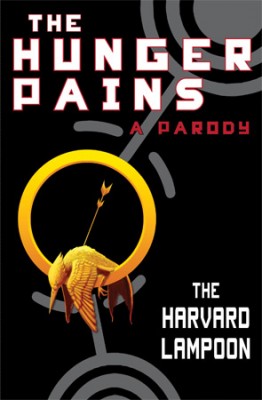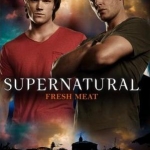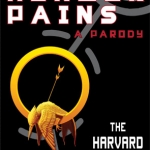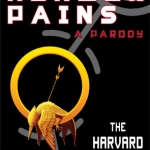
The debut of the much anticipated Hunger Games film adaptation is just around the corner, and fandom for the book trilogy written by Suzanne Collins has never been greater. It seems like the best and worst time, then, for the Harvard Lampoon to present their scene for scene parody, The Hunger Pains. I say “worst” only because I know many Hunger Games devotees will bristle at the notion of anyone poking fun at their favorite stories and characters. They need not worry, though, because The Hunger Pains is a loving parody that clearly is written for the fans and not in spite of them.
The parody’s young heroine, Kantkiss Neverclean, lives with her widowed mother and spiteful younger sister Prin (short for Princess) in Peaceland, the totalitarian and post-apocalyptic remains of the former United States. Each district of Peaceland specializes in a particular vocation or product. One is the Theatre District, another regularly trains up District Attorneys, and yet another simply watches the movie District 9 all day every day. Kantkiss’s District 12 is the Telemarketing District, renowned as much for its tactless marketing techniques as it is for its abject poverty. All the districts fall under the watchful eye of the Capitol, a central ruling region filled with garish extravagance and ridiculous fashion.
Though her origins seem similar to those of one Katniss Everdeen, Kantkiss’s life trajectory lands her in a far shallower end of the gene pool. Blundering through her days as a clueless and filthy denizen of the neighborhood known as “The Crack,” Kantkiss counts her fellow hunter, the charming boy named Carol Handsomestein, as her only friend. Her routine involves scrounging for things to eat outside a flimsy fence and unleashing excessive murder upon the local wildlife. Her idyllic life changes forever when she accidentally volunteers herself as a contestant for The Hunger Games, the second highest rated reality show in Peaceland.
Much like the Games of the original trilogy, Peaceland’s Hunger Games bring one boy and one girl from each district into a televised battle to the death. All the districts’ tributes become celebrities during their time in the arena, but only one child can emerge victorious and alive. Joining Kantkiss from District 12 is Pita Malarkey, the chubby son of the town’s baker. Awkward, well intentioned, and generally useless, Pita complements Kantkiss’s overall vapidity and cluelessness.
The basic story will be familiar to anyone who has read the first book in the original Hunger Games series, but the twists and changes in The Hunger Pains are clever and funny enough to be welcome surprises. All the major story beats from the original are here, as are caricatured versions of the intense, brutal, and pompous characters that inhabit Suzanne Collins’s world. Comedy can be a hard sell for me, but I literally had some laughing out loud moments while reading this parody. From the District 12 tributes’ early dealings with Effu Poorpeople and previous Games winner Buttitch Totalapathy to their encounters, conflicts, and alliances with their competition in the arena, The Hunger Pains nails the humor solidly throughout.
Absurdity and a heightened and ridiculous reality will amuse any readers, but fans of The Hunger Games will get the most out of this book. If imitation is the highest form of flattery, then parody just might be the highest form of imitation. All the jabs at the original story are fun and most are inoffensive to the source material. I have no doubt that some Hunger Games fans who are extremely close to Collins’s trilogy will take offense to the snark and barbs in the parody, but it all really does play as a tribute of the least malicious sort. The Hunger Pains released on February 7, 2012, and is available in bookstores now.






